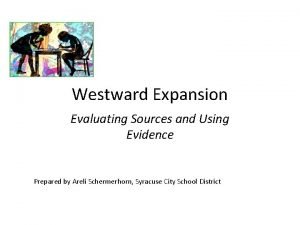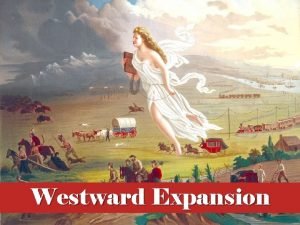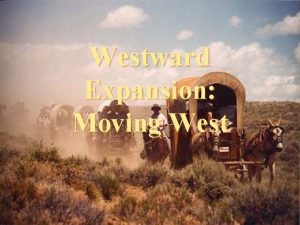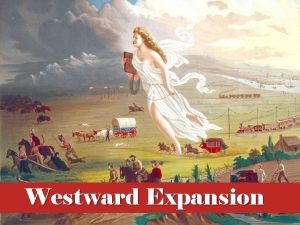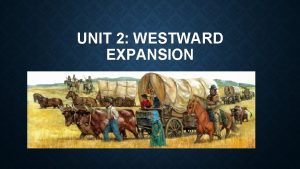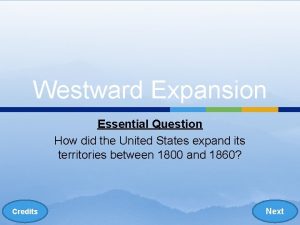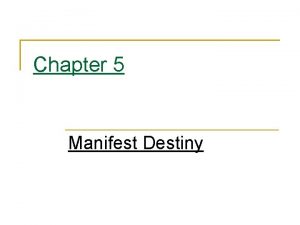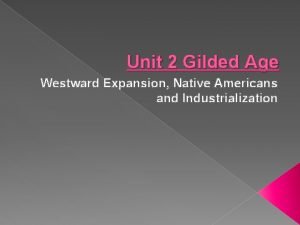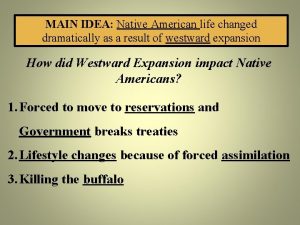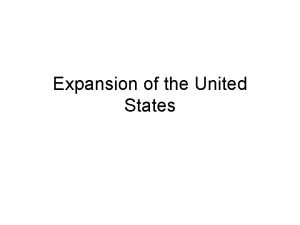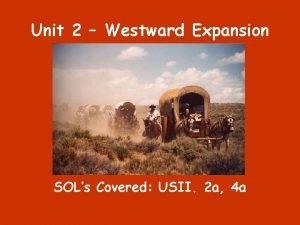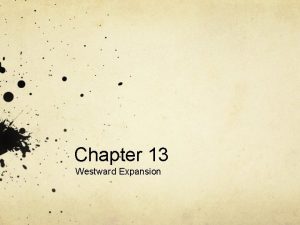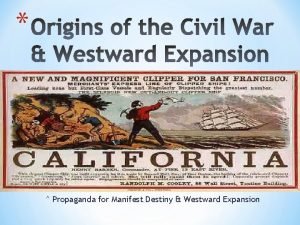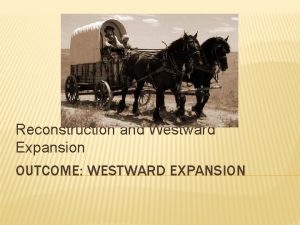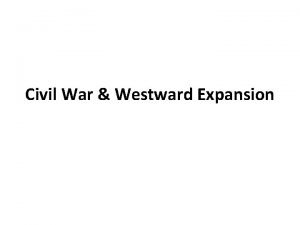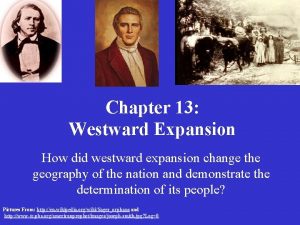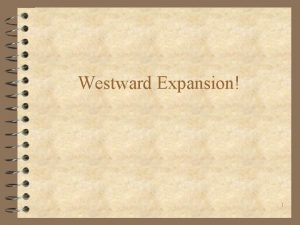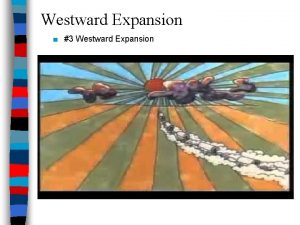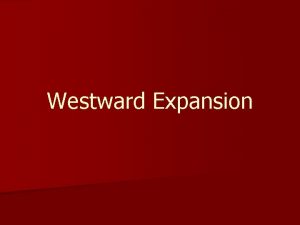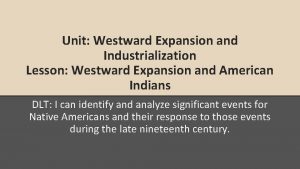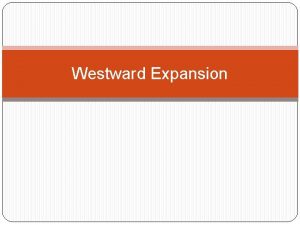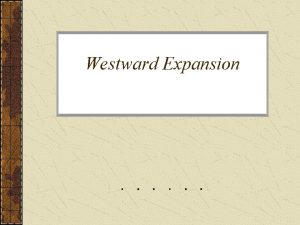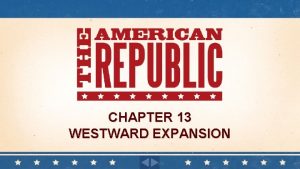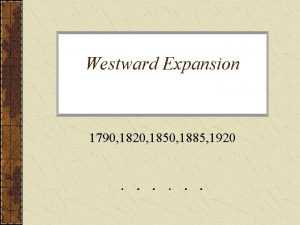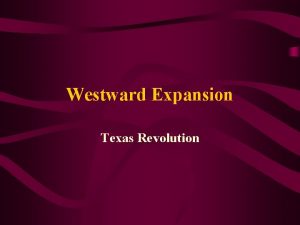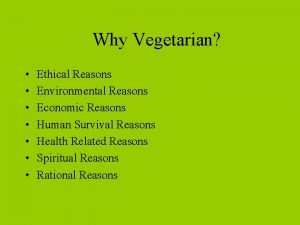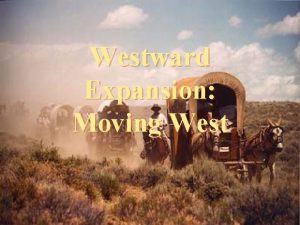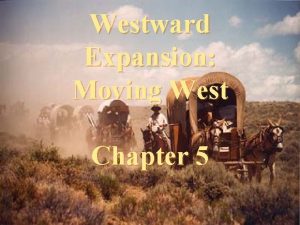Westward Expansion Review I Reasons for Westward Expansion
































- Slides: 32

Westward Expansion Review

I. Reasons for Westward Expansion 1. Manifest Destiny- Americans had the God given right to spread themselves across the continent, “from sea to shining sea”

2. Gold and Silver discovered- the thought of getting rich quick led many people to head west in search of valuable minerals

3. Homestead act (1862)- a law that provided 160 acres of free land in the west to anyone who would live on and cultivate the land for 5 years.

4. Transcontinental Railroad- completed in 1869, this railroad line connected the East Coast and the West Coast of the United States


What impact will the growth of railroads have on industrialization and urbanization?

II. Native American conflict 1. As American citizens began settling the Plains, they came into conflict with the Plain Indians • the buffalo were killed by settlers, hunters and railroad workers • Settlers moved on to land promised to Plains Indian tribes • Conflict led to Indian Wars (a series of battles and conflicts between settlers, U. S. government vs. Plains Indians) Ø Little Big Horn Ø Wounded Knee Massacre



Chief Joseph of the Nez Perce “I am tired of fighting. Hear me, my chiefs! I am tired; my heart is sick and sad. From where the sun now stands, I will fight no more forever. "


2. By 1890, most resistance from Plains Indians was over and most tribes agreed to live on Reservations 3. Government tried to assimilate Native Americans Ø Dawes Act Ø Carlisle School

III. “End” of Western Expansion Ø By 1890, most of the open range in the U. S. was populated by U. S. citizens and Native Americans had abandoned resistance States and Territories - 1860

V. “End” of Western Expansion Ø By 1890, most of the open range in the U. S. was populated by U. S. citizens and Native Americans had abandoned resistance States and Territories - 1890

Industrialization And Urbanization

Industrialization: growth of the United States as an industrial power; the U. S. changes from a farming society to an industrial society and becomes an economic power Urbanization: the growth of cities; in the late 1800 s, the U. S. urbanized because of the technological and industrial boom, which attracted unemployed American farmers and immigrants to cities for factory jobs

I. Economic Review Capitalism is an economic system in which the means of production are all or mostly privately owned and operated for profit. Means of production- the resources and machines with which goods and services are created ØLaissez-Faire- meant government would keep its “hands off” of the economy and not regulate business ØThe economy should regulate itself ØSocial Darwinism- “Survival of fittest”-government should not regulate b/c it would stop natural progress

“RADICAL” Alternatives Socialism- political and economic system in which: • Most of the means of production are publicly owned • Profit is shared among workers and owners

II. Big Business Emerges 1. Corporations (businesses owned by stockholders) 2. Monopolies/Trusts- when a business has most or all the business in an industry • Many people feared monopolies were too powerful • Limited competition, control consumer prices • Too much influence on government (bribes; graft)

Lady Liberty (freedom) Capital • The snake is labeled a monopoly. Snakes are deadly and can coil (wrap) itself around something until its in their grip of control. • Big business leaders knew their tactics were ruthless. Therefore, they persuaded Congress to protect their business interests (i. e. , low tariffs) with bribes and large campaign contributions.


III. Robber Barons- negative view of big businessmen as greedy and ruthless Captains of Industry- positive view of big businessmen as smart entrepreneurs Examples: Rockefeller • Standard Oil Monopoly • Used vertical and horizontal integration • Standard Oil is broken up by the government Carnegie • Rags to riches • U. S. Steel corporation • Philanthropy

IV. New business tactics- Vertical integration, horizontal integration, pools, rebates

V. New Production Techniques- Mass production, assembly line

VI. Impact of Industrialization 1. Poor working Conditions- Long hours, low pay, dangerous conditions! • Triangle Shirtwaist Factory Fire 2. Increased immigration and urbanization 3. Child labor 4. Big business influences government VII. Labor Unions Form 1. Form to get shorter hours, safer conditions, better pay • Boycott, strike 2. Unions are unsuccessful during this time

VIII. Urbanization- Growth of cities; industry and immigration lead to the growth of cities 1. The poor lived in tenements • Overcrowding led to sanitation problems and crime 2. Technology and culture in cities • Architects use steel to build skyscrapers • Streetcars, trolleys, subways and bridges all improve transportation 3. Rise of Political Machines • Political Machine- an organization of people that influence enough votes to control a local government • Boss Tweed and Tammany Hall • Corrupt

Immigration New Immigration (1870 -1920)- time period in U. S. history when massive amounts of immigrants arrived, many from countries and cultures not yet represented in the U. S.

I. Why Immigrants came 1. Push Factors- famine (Ireland), religious persecution (pogroms), poverty 2. Pull Factors. JOBS! , Religious freedom, education, relatives already in U. S. , American Dream, social mobility 3. Today- ____________________ II. Journey Over 1. Many immigrants traveled in steerage (cheaper, but disease could spread) 2. European immigrants Ellis Island, NY Asian Immigrants Angel Island, San Francisco 3. Many came over as broken families

Salad Bowl vs. US culture is made up of distinct immigrant cultures mixed together Melting Pot US culture is made up of immigrant cultures which melt together to form a new US culture

• Nativism- discrimination against new immigrants; belief that the U. S. should have a restrictive immigration policy Ø Especially b/c of JOB COMPETION! 4. Assimilation- drop your own culture and conform to the culture of another group; did not happen quickly • Ethnic communities • Culture shock

4. At home and at work • Tenement neighborhoods • Long hours, low pay, dangerous conditions- often all members of the family had to work • Given jobs and favors by POLITCAL MACHINES in exchange for votes IV. End of the New “WAVE” of Immigration 1. Immigration Laws • Chinese Exclusion Act, Immigration Quota Acts of 1921 + 1924 • Passed b/c of Nativism, discrimination and fear
 Jimmy fallon gadsden purchase
Jimmy fallon gadsden purchase Westward expansion
Westward expansion Essential questions for westward expansion
Essential questions for westward expansion Westward expansion vocabulary
Westward expansion vocabulary Unit 3 rev. statehood and westward expansion
Unit 3 rev. statehood and westward expansion Westward expansion thesis statement
Westward expansion thesis statement Who made
Who made Westward expansion essential questions
Westward expansion essential questions Westward expansion vocabulary
Westward expansion vocabulary Unit 2 westward expansion vocabulary
Unit 2 westward expansion vocabulary Westward expansion virtual field trip
Westward expansion virtual field trip Westward expansion clipart
Westward expansion clipart Westward expansion wagon
Westward expansion wagon Gilded age westward expansion
Gilded age westward expansion Westward expansion acrostic poem
Westward expansion acrostic poem Assimilation westward expansion
Assimilation westward expansion Effects of westward expansion
Effects of westward expansion American historama lewis and clark
American historama lewis and clark Westward expansion map
Westward expansion map Westward expansion lewis and clark
Westward expansion lewis and clark Unit 2 westward expansion vocabulary
Unit 2 westward expansion vocabulary The oregon trail
The oregon trail Manifest destiny propaganda
Manifest destiny propaganda Great plains westward expansion
Great plains westward expansion Reasons for business expansion
Reasons for business expansion Reasons for expansion
Reasons for expansion Aktiv exspektans
Aktiv exspektans Bo bergman jag fryser om dina händer
Bo bergman jag fryser om dina händer Bat mitza
Bat mitza Ro i rom pax
Ro i rom pax Stig kerman
Stig kerman Novell typiska drag
Novell typiska drag Varför kallas perioden 1918-1939 för mellankrigstiden
Varför kallas perioden 1918-1939 för mellankrigstiden

